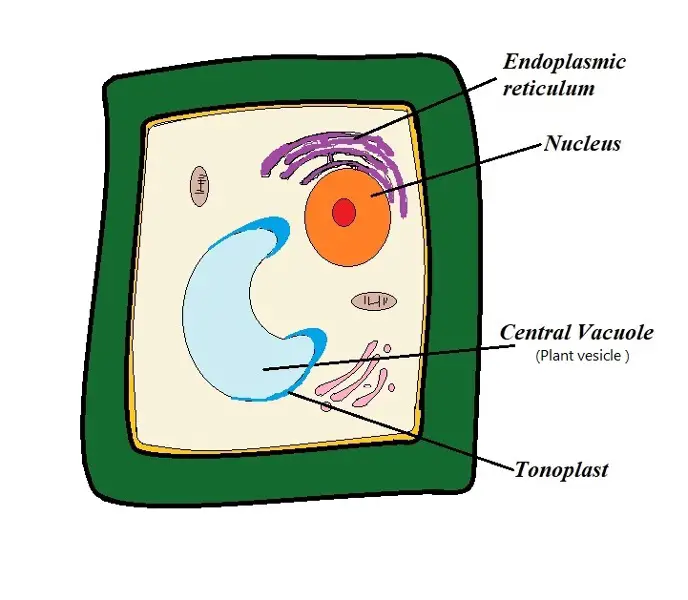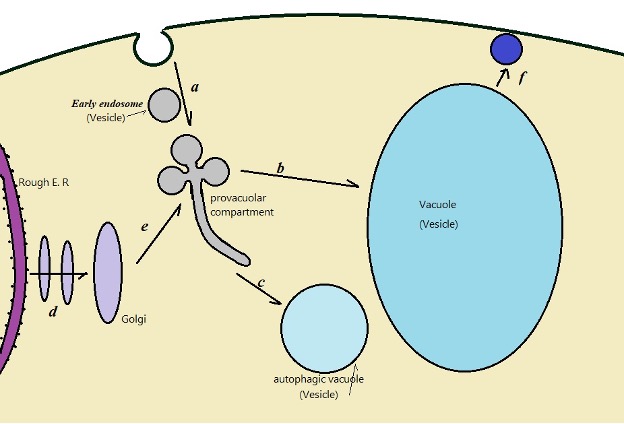Do Plant Cells have Vesicles?
Like animals, plants also have several types of vesicles which are involved in a number of functions.
Some of the best-studied plant vesicles include:
Vacuoles
Like vesicles, vacuoles consist of a surrounding membrane. Though there are several differences between vacuoles and vesicles, a plant vacuole is described as a type of vesicle.
Compared to other vesicles, vacuoles are large in size, taking between 30 and 80 percent of the total cell volume (measuring between 2 and 7 um3).
They are also differentiated from other vesicles in that they are primarily involved in the storage of water and some nutrients.
Formation of vacuoles - Generally, plant vacuoles are formed through the fusion of several vesicles released by the endoplasmic reticulum and Golgi complex. However, based on a number of studies, the process has been shown to start with the formation of prevacuolar compartment (PVC) through endocytosis.
Other vesicular bodies are then produced and released by the endoplasmic reticulum and Golgi apparatus which merge with the prevacuolar compartment to form the vacuole.
In plants, there are two main types of vacuoles that include:
Lytic vacuoles - Contain hydrolases used for degrading various cellular substances (unwanted material)
Protein storage vacuoles - Contain various proteins
* Animal cells also contain vacuoles. However, unlike plant cells, animal cells contain several vacuoles that are much smaller in size.
Functions
Through plant vacuoles are primarily involved in water storage, they are also involved in a number of important functions that include:
· Regulate internal pH and internal turgor pressure
· Isolate unwanted material and some waste products from the cell
· Storing proteins
· Promote structural rigidity of the cell
* In animal cells, the vacuoles are involved in the transport of various materials through exocytosis and endocytosis.
Transport vesicles - As the name suggests, transport vesicles are involved in the transport of molecules within the cell (primarily proteins). Typically, they are formed through a budding process where they bud off from the donor compartment (the rough endoplasmic reticulum).
Here, proteins are first formed by ribosomeson the surface of endoplasmic reticulum. These proteins are then transported along the endoplasmic reticulum and eventually released into the final compartment, transport vesicle, which buds off and transports the proteins to the target destination.
* Extracellular vesicles in plants can also be described as transport vesicles. They are small vesicles involved in the intercellular transport of various molecules including RNAs and proteins. They have also been associated with immune responses against invading organisms.
Secretory vesicles - Secretory vesicles in plants are formed through the same process as transport vesicles. Though they do not themselves secrete material, they are involved in the transport of cargo like hormones and transmitters from various cell organelles to the cell membrane.
Here, the vesicles fuse with the cell membrane allowing contents to be released into the extracellular space.
Other Types of Vesicles
Some of the other organelles classified as vesicles include:
Lysosomes - Lysosomes are small sacs within animal cells (and some plant cells according to new evidence) that contain digestive enzymes. Various materials are transported to the lysosome for degradation so that they can be recycled or expelled.
Lysosomal enzymes also play an important role in initiating cell death.
Peroxisomes - Peroxisomes also contain enzymes. However, these enzymes are primarily used for breaking down various nutrient materials including fatty acids and hydrogen peroxide (oxidation reactions).
Through oxidation reaction, they also play an an important role in detoxification where they break down/degrade toxic substances (e.g. some poisons).
See also: Exosomes and Stem Cells
Return to Do Animal Cells have Vesicles?
Return from Do Plant Cells have Vesicles? to MicroscopeMaster home
References
Christopher Tricarico, James Clancy, and Crislyn D'Souza-Schorey. (2017). Biology and biogenesis of shed microvesicles.
Maojiao Li, Li Liao and Weidong Tian. (2020). Extracellular Vesicles Derived From Apoptotic Cells: An Essential Link Between Death and Regeneration.
Nina Pettersen Hessvik and Alicia Llorente. (2018). Current knowledge on exosome biogenesis and release.
Xiaona Tan et al. (2019). A Review of Plant Vacuoles: Formation, Located Proteins, and Functions.
Links
https://www.sciencedirect.com/science/article/pii/S016372581830038X
Find out how to advertise on MicroscopeMaster!






